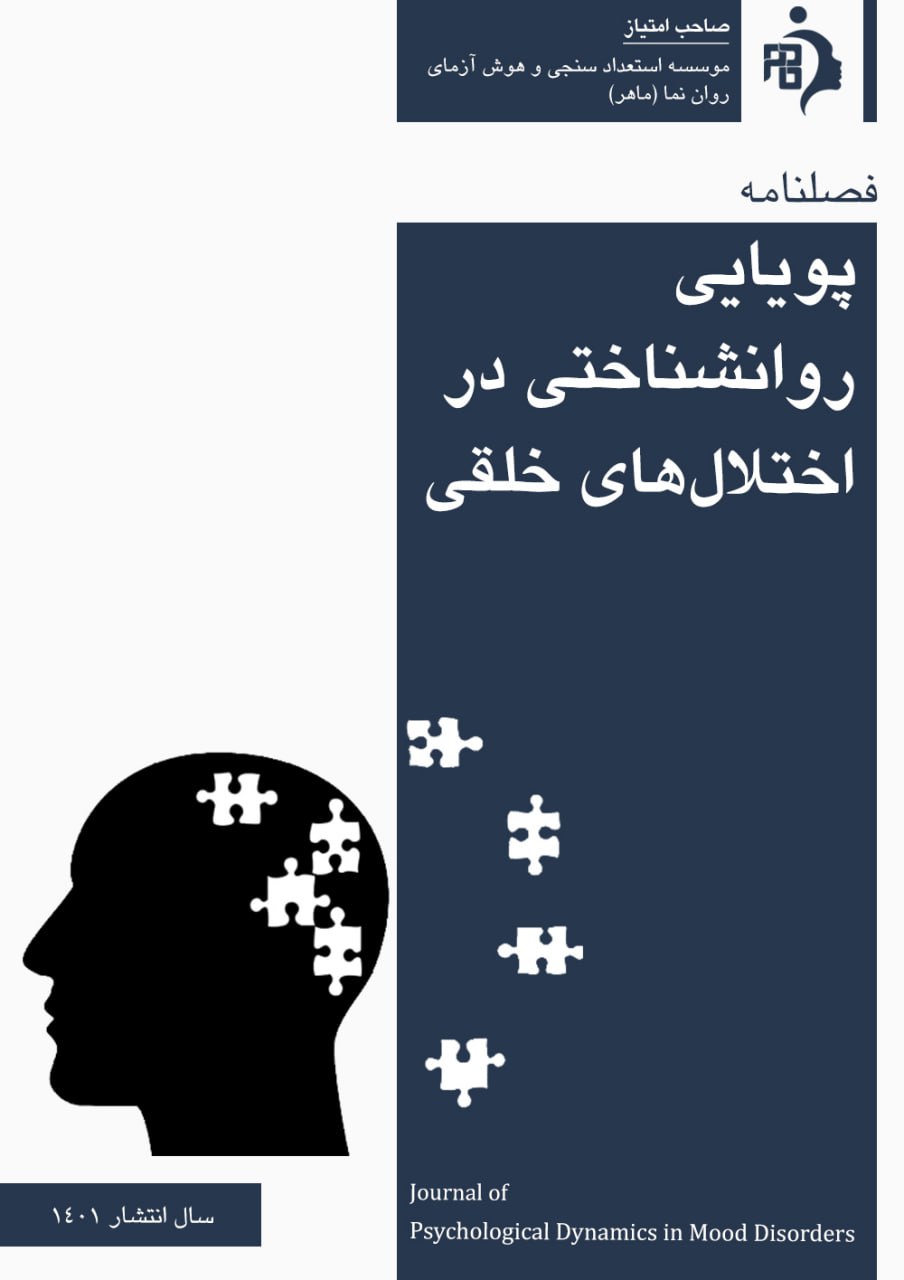روایی تشخیصی «روش ارزیابی شدلر- وستن» در نمونه غیربالینی صنعت نفت ایران
کلمات کلیدی:
روایی تشخیصی, روش ارزیابی شدلر- وستن, اختلالهای شخصیت, نمونه غیربالینیچکیده
زمینه و هدف: بررسی روایی تشخیصی ابزارهای مختلف جهت شناسایی مبتلایان به اختلالهای شخصیتی اهمیت زیادی دارد. در نتیجه، هدف این مطالعه تعیین روایی تشخیصی روش ارزیابی شدلر- وستن در نمونه غیربالینی صنعت نفت ایران بود.
روش و مواد: این پژوهش از نظر هدف، کاربردی و از نظر شیوه اجرا کمّی بود. جامعه پژوهش کارکنان صنعت نفت متقاضی تصدی پستهای مدیریتی در سال 1402 بودند که تعداد 400 نفر از آنها با روش نمونهگیری هدفمند بهعنوان نمونه انتخاب شدند. دادهها با روش ارزیابی شدلر- وستن (SWAP-200) گردآوری و برای تعیین روایی تشخیصی از سه روش فاصله اطمینان، ضریب حساسیت و ضریب وضوحگرایی در نرمافزار SPSS استفاده شد.
یافتهها: یافتهها نشان داد که هر 12 مقیاس روش ارزیابی شدلر- وستن شامل پارانوئید، اسکیزوئید، اسکیزوتایپال، ضداجتماعی، مرزی، هیستریانیک، نارسیستیک، اجتنابی، وابسته، وسواسی، افسرده و منفعل- پرخاشگر به دلیل داشتن فاصله اطمینان بیشتر از 2 انحراف معیار دارای روایی تشخیصی مناسبی بود. همچنین، 9 مقیاس پارانوئید، اسکیزوئید، ضداجتماعی، هیستریانیک، نارسیستیک، اجتنابی، وابسته، وسواسی و منفعل- پرخاشگر به دلیل داشتن ضریب حساسیت و ضریب وضوحگرایی بهترتیب بالاتر از 90/0 و 70/0 حاکی از روایی تشخیصی مناسب بودند، اما مقیاس اسکیزوتایپال به دلیل ضریب حساسیت 21/0 و ضریب وضوحگرایی 80/0، مقیاس مرزی به دلیل ضریب حساسیت 35/0 و ضریب وضوحگرایی 70/0 و مقیاس افسرده به دلیل ضریب وضوحگرایی 57/0 و ضریب حساسیت 65/0 حاکی از روایی تشخیصی نامناسب بود.
نتیجهگیری: طبق نتایج این مطالعه، متخصصان و درمانگران اختلالهای شخصیتی میتوانند از روش ارزیابی شدلر- وستن بهعنوان یک ابزار دارای روایی تشخیصی مناسب استفاده نمایند.
دانلودها
مراجع
Alibakhshiyan, S., Sarafraz, M. R., Belyad, M. R., Kamkari, K., & Hajiheydari, M. (2024). Concurrent validity of "Shedler-Westen assessment method" and "fourth edition of Millon’s clinical multiaxial inventory" in the non-clinical sample of Iran's oil industry. Sociology of Education. 10(2), 254-263. https://doi.org/10.22034/ijes.2024.2043881.1640
Bradley, R., Hilsenroth, M., Guarnaccia, C., & Westen, D. (2007). Relationship between clinician assessment and self-assessment of personality disorders using the SWAP-200 and PAI. Psychological Assessment, 19(2), 225-229. https://doi.org/10.1037/1040-3590.19.2.225
Cao, Y., Yan, B., & Teng, Y. (2023). The impact of green human resource management on hospitality employees’ quitting intention: A dual perspective study. Journal of Hospitality and Tourism Management, 57, 270-283. https://doi.org/10.1016/j.jhtm.2023.10.012
DeFife, J. A., Malone, J. C., DiLallo, J., & Westen, D. (2013). Assessing adolescent personality disorders with the Shedler–Westen assessment procedure for adolescents. Clinical Psychology: Science and Practice, 20(4), 393-407. https://doi.org/10.1111/cpsp.12049
Garner, A. R., Blocher, N., Tierney, D., Baumgardner, M., Watson, A., Romero, G., & et al. (2022). Applying the DSM-5 alternative model of personality disorders and the Shedler-Westen assessment procedure to the classic case of “Madeline G.”: Novice and expert rater convergences and divergence. Frontiers in Psychology, 13(794616), 1-8. https://doi.org/10.3389/fpsyg.2022.794616
Harrison, S., Grover, S., & Furnham, A. (2018). The perception of sub-clinical personality disorders by employers, employees and co-workers. Psychiatry Research, 270, 1082-1091. https://doi.org/10.1016/j.psychres.2018.05.036
Hein, K. E., Glass, I. V., Frankenburg, F. R., Fitzmaurice, G. M., & Zanarini, M. C. (2025). Emptiness in patients with borderline personality disorder: Severity and predictors of outcome over 24 years of prospective follow-up. Journal of Affective Disorders, 372, 234-240. https://doi.org/10.1016/j.jad.2024.11.075
Kashanaki, H., Pournaghash, S. S., Ghorbani, N., & Bahrami Ehsan, H. (2021). Study of the effectiveness of mindful sensorimotor interventions in the treatment of abnormal personality patterns leading to depression and anxiety: a mixed-method study. Journal of Psychological Sciences, 20(106), 1699-1716. http://dx.doi.org/10.52547/JPS.20.106.1699
Lehmann, M. E., & Hilsenroth, M. J. (2011). Evaluating psychological insight in a clinical sample using the Shedler-Westen assessment procedure. The Journal of Nervous and Mental Disease, 199(5), 354-359. https://doi.org/10.1097/nmd.0b013e3182175138
Marin-Avallen, L., McGauley, G., Campbell, C., & Fonagy, P. (2005). Using the SWAP-
in a personality-disordered forensic population; is it valid, reliable and useful? Journal of
Criminal Behavior and Mental Health, 15(1), 28-45. https://doi.org/10.1002/cbm.35
Oasi, O., Buonarrivo, L., Codazzi, A., Passalacqua, M., Ricci, G. M. R., Straccamore, F., & Bezzi, R. (2017). Assessing personality change with Blatt's anaclitic and introjective configurations and Shedler-Westen Assessment Procedure profiles: two case studies in psychodynamic treatment. Research in Psychotherapy: Psychopathology, Process and Outcome, 20(1), 63-80. https://doi.org/10.4081/ripppo.2017.231
Piwowar-Sulej, K., Blstakova, J., Lizbetinova, L., & Zagorsek, B. (2024). The impact of digitalization on employees' future competencies: has human resource development a conditional role here? Journal of Organizational Change Management, 37(8), 36-52. https://doi.org/10.1108/JOCM-10-2023-0426
Post, R. M., Leverich, G. S., McElroy, S. L., Kupka, R., Suppes, T., Altshuler, L. L., & et al. (2022). Are personality disorders in bipolar patients more frequent in the US than Europe? European Neuropsychopharmacology, 58, 47-54. https://doi.org/10.1016/j.euroneuro.2022.02.007
Rambelji, K., Vander Heijden, P. T., & Egger, J. I. M. (2024). Prototypes and dimensions: Relations between the Shedler-Westen assessment procedure (SWAP-200) and the personality psychopathology five (PSY-5) maladaptive personality traits. International Journal of Psychology and Psychological Therapy, 24(3), 373-383. https://www.ijpsy.com/volumen24/num3/671.html
Shedler, J., & Westen, D. (2007). The Shedler–Westen assessment procedure (SWAP): Making personality diagnosis clinically meaningful. Journal of Personality Assessment, 89(1), 41-55. https://doi.org/10.1080/00223890701357092
Smits, P. G., Foek-Rambelje, K. L. S., Rinne, T., Vander Heijden, P. T., Kempes, M. M., & Egger, J. I. M. (2021). Personality assessment with the Shedler-Westen assessment procedure 200 in a forensic sample: Criterion validity and contribution to structured forensic clinical judgement. The Journal of Forensic Psychiatry & Psychology, 32(5), 736-751. https://doi.org/10.1080/14789949.2021.1903066
Welch, J. E., Luo, W., Ambroise, K. J., Choi, Y. N., Jones, K. G., De Rouen, A., & Fineberg, S. K. (2024). Tell Me about yourself: Analyzing self-referential language use in borderline personality disorder. Journal of Psychiatric Research, 180, 428-438. https://doi.org/10.1016/j.jpsychires.2024.11.011
Westen, D., Waller, N. G., Shedler, J., & Blagov, P. S. (2014). Dimensions of personality and personality pathology: Factor structure of the Shedler-Westen assessment procedure-II (SWAP-II). Journal of Personality Disorders, 28(2), 281-318. https://doi.org/10.1521/pedi_2012_26_059
Young, M. (2024). Advances in management of personality disorders in a residential setting. Advances in Psychiatry and Behavioral Health, 4(1), 147-155. https://doi.org/10.1016/j.ypsc.2024.05.010



























